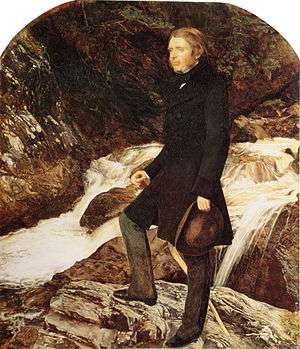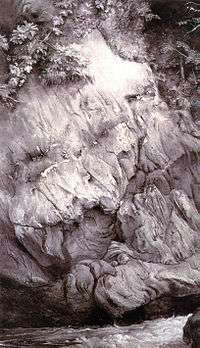Glen Finglas
Glen Finglas (Scottish Gaelic: Gleann Fhionnghlais) is a glen in the Trossachs, in the Stirling council area of Scotland. It is an area of forest in Highlands of the former county of Perthshire, north of Brig o' Turk, close to Callander in Menteith. (Includes commentary.) To the west is Loch Katrine.


Part of the Glen was a royal hunting forest. From the 1450s, laws protected the forest area and restricted the rights of tenants in surrounding lands to encourage deer for the hunt.[1]
A flat mound called "Tom Buidhe" (the yellow knoll) near the Glen Finglas Reservoir is thought to be the site of the Hunt Hall, first built for James II of Scotland in the 1400s.[2] James IV came to the Hunt Hall in August 1505 bringing tents and pavillions for extra accomodation. He was supplied with dairy goods by two women from Duntreath, and eels and pikes from the Lake of Menteith. Mary of Guise hunted in the Glen with James V soon after her arrival in Scotland in 1539.[3]
The Scottish novelist and poet Sir Walter Scott (1771–1832) wrote the poem "Glenfinlas; or Lord Ronald's Coronach" in 1803.
The Glenfinglas estate was acquired by the Woodland Trust Scotland in 1996[4] and is open to the public.
Ruskin and Millais
The leading Victorian art critic John Ruskin (1819–1900) and the Pre-Raphaelite painter John Everett Millais (1829–1896) spent the summer of 1853 together at Glenfinlas.[5] Millais started a painting of John Ruskin in front of a waterfall during the visit, which he finished the following year. The painting is held in the Ashmolean museum, and has been shown at several exhibitions, including "The Pre-Raphaelites" at Tate Britain in London during 2004.[6] John Ruskin himself was especially interested in the rock formations and, although primarily an art critic, undertook his own studies of these.
References
- John M. Gilbert, Hunting and Hunting Reserves in Medieval Scotland (John Donald, Edinburgh, 1979), p. 103, 114-5: Unpublished records of royal hunting trips to Glen Finglas and other royal reserves can be found in the National Records of Scotland E32 series.
- John M. Gilbert, Hunting and Hunting Reserves in Medieval Scotland (John Donald, Edinburgh, 1979), p. 80-2.
- James Balfour Paul, Accounts of the Treasurer, vol. 3 (Edinburgh, 1901), pp. 156-7.
- "Wood Pasture: Glen Finglas". Scottish Natural Heritage.
- Ruskin and Millais at Glenfinlas, The Burlington Magazine, Vol. 138, No. 1117, pages 228–234, April 1996. (Accessed via JSTOR, UK.)
- Pre-Raphaelite Vision: Truth to Nature, Tate Britain, London, UK, 12 February – 3 May 2004.
External Links
https://www.woodlandtrust.org.uk/visiting-woods/wood-information/glen-finglas/history/